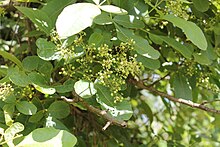| Searsia parviflora | |
|---|---|

| |
| Conservation status | |
 Least Concern (IUCN 3.1) | |
| Scientific classification | |
| Kingdom: | Plantae |
| Clade: | Tracheophytes |
| Clade: | Angiosperms |
| Clade: | Eudicots |
| Clade: | Rosids |
| Order: | Sapindales |
| Family: | Anacardiaceae |
| Genus: | Searsia |
| Species: | S. parviflora |
| Binomial name | |
| Searsia parviflora (Roxb.) F.A.Barkley | |
| Synonyms | |
| |

Searsia parviflora, commonly known as small-flowered poison sumac, is a species of flowering plant native to the northern Indian subcontinent and Myanmar. It is a much-branched shrub or small tree bearing stalked leaves with three leaflets; the end leaflet is larger than the other two. The leaflets are obovate, with rounded tips, tapering bases and irregularly toothed margins. The flowers are tiny, yellowish and fragrant. The fruit is small, round and red when ripe. S. parviflora is found in the Himalayas, from Kumaun to Bhutan, at elevations of 700–1,100 metres (2,300–3,600 ft).
References
- Lakhey, P. & Pathak, J. 2020. Searsia parviflora. The IUCN Red List of Threatened Species 2020: e.T150471713A152202002. https://dx.doi.org/10.2305/IUCN.UK.2020-3.RLTS.T150471713A152202002.en. Accessed 4 November 2024.
- ^ "Searsia parviflora (Roxb.) F.A.Barkley". Plants of the World Online. Royal Botanic Gardens, Kew. Retrieved 4 November 2024.
- Small Flowered Poison Sumac
| Taxon identifiers | |
|---|---|
| Searsia parviflora | |
| Toxicodendron parviflorum | |
| Rhus parviflora | |
This Anacardiaceae article is a stub. You can help Misplaced Pages by expanding it. |